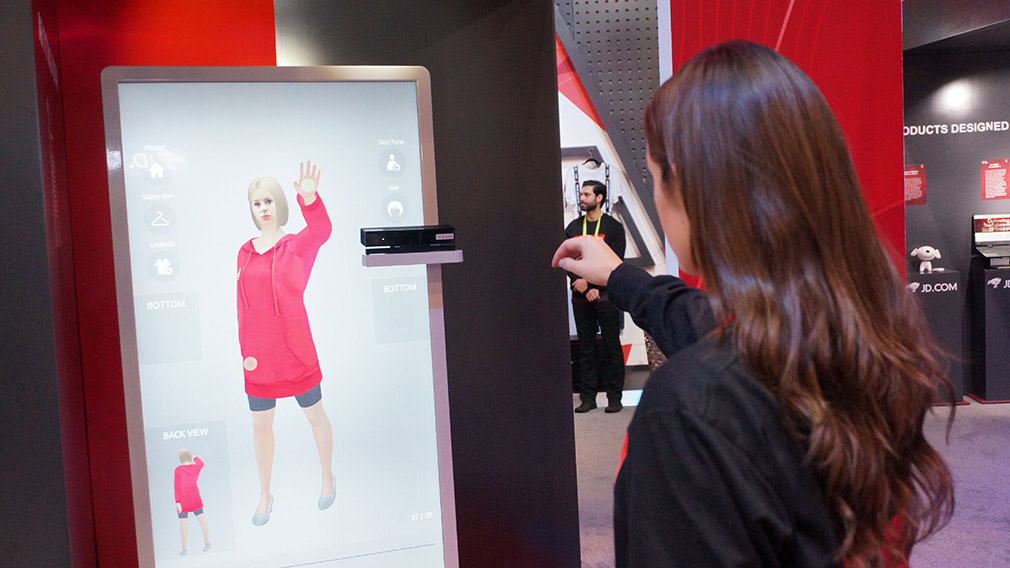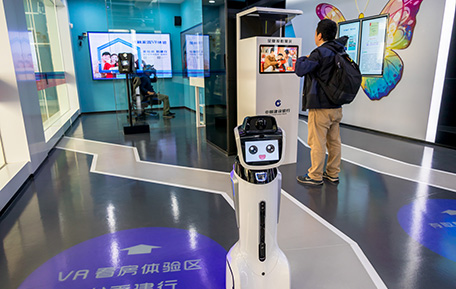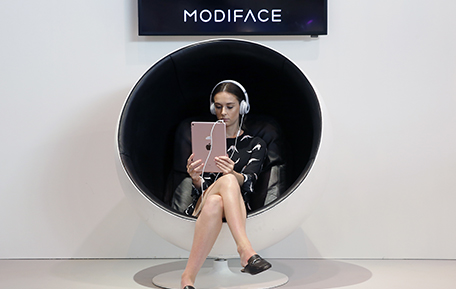Augmenting away online, offline barriers
 Lachlan Colquhoun
Lachlan Colquhoun
03:09pm January 09 2019

At this month’s Consumer Electronic Show in Las Vegas, an employee of Chinese tech giant JD.com shows an augmented reality system that allows customers to virtually try on clothing at shops. (Getty)
You’re sitting in a café in the inner Sydney suburb of Surry Hills and start playing with your phone.
You open an app, a shopping one, and it shows there are a dozen retailers within several hundred metres, all showcasing offers and bargains.
On impulse, you leave the café and head towards the stores, using geolocation features and street view on your phone and make the purchase which has caught your eye.
Meet Sweep, a new app being rolled out in Surry Hills as a proof of concept before going national – and potentially even international. Think Facebook for shopping, which along with Google maps and augmented reality (AR), the founders claim has inspired an app aiming to revolutionise how people shop – including driving them back into physical stores.
“It is a combination of the virtual world and the physical, and that is what AR is all about,” says Robyn Foyster, whose company AR Tech has developed Sweep.
“It can turn the smartphone into a local AR shopping mall by bringing all this technology together.
“You can set and change the radius to capture the deals you want, and you can customize your feed based on what you are interested in.”
The app is only one example of AR, one of the hot topics of the moment and an area which research firm International Data Corporation (IDC) believes attracted investment of more than $US20 billion in 2018 across all industries. Unlike virtual reality (VR) which digitally recreates real-life, AR manipulates elements of a real-world setting rather than blocking it out.
At the Australian School of Business at UNSW, marketing academic Mathew Chylinksi has been studying AR in retail. He believes it has the potential to break down the barrier between online and offline, and enable what he calls “omni channel experiences across the customer journey”.
AR is also more effective than VR in a retail environment because instead of immersing customers in a synthetic environment, AR supplements reality rather than replacing it.
“AR transcends both the online and the offline,” says Chylinksi.
“Because you can produce these virtual images embedded in a physical context it produces a natural connection.”
While the retail sector has been one of the biggest adopters of AR to date, IDC claims commercial interest continues to accelerate in several industries as hardware and software improves, and use cases evolve. In the finance sector, its largely been based around assisting customers find ATM’s and branch locations through combining phone cameras with geolocation in the same way that Sweep directs users to merchants.

Intelligent service robot works in China's first “unmanned bank” at a China Construction Bank branch in April 2018 in Shanghai, where customers have access to video teller machines and interactive services including augmented reality. (Getty)
Google Glass – a type of “smart glasses” launched in 2013 -- was also trialled by banks but the original prototype was pulled by the tech giant a few years later amid mixed response to its cost, use cases and marketing. However, AR use cases are rising with some banks bundling it into the property buying experience, delivering mortgage calculator and application tools. In 2014, Westpac New Zealand also became the first bank in the world to unveil the roll out of AR in its banking app for account management, bringing to life checking account balances and spending patterns with 3D imagery.
Future applications could create virtual branches and enhance authentication, where AR is combined with biometric technology for security purposes, experts say.
“Augmented reality is an undeniable truth in the banking industry now,” an Infosys report,
Future of Consumer Banking: The Augmented Way, released last year, says.
For retailers, AR applications aim to address the issue of customer conversion, where interested buyers fail to follow through to the online checkout and complete a purchase due to the mental hurdle of what is seen online and the reality of owning the product.
And some of the world’s largest retailers are increasingly dabbling in the space.
In 2017, furnishing giant Ikea launched “Place”, an app that leverages Apple’s new ARKit technology and enables customers to insert, share and scale products into any space on their smartphones, reducing any nagging doubts on how a couch looks at home.
In the world of fashion, French company L’Oreal last year purchased AR company Modiface and rolled out an application where customers can try on virtual makeup, similar to technology used by European eyewear company Mister Spex where buyers can try on virtual sunglasses. Closer to home, Australian paint company Dulux allows customers to test different colours on an AR app before they buy.

A woman uses a tablet to test the Modiface 3D makeup system during the Viva Technology show in Paris last year. (Getty)
"ARKit gives us the opportunity to help shape the development of AR as an accessible tool for real-life decision making," Michael Valdsgaard, leader digital transformation at Inter IKEA Systems, said when launching Place.
Chylinski says the beauty of AR applications is that they exist in both the online and offline world, converting more online purchases but also directing people into physical stores to seek out what they have tried through AR. Despite the growth in online shopping, he says future applications may actually be rolled out more in bricks and mortar stories where they can improve customer engagement and transform the shopping experience.
“When they compete against a big online retailer like Amazon, physical retailers are disadvantaged because they have to keep smaller assortments instore than are available in an online catalogue,” he says.
“But AR has the ability to bring that processing power into the physical store. You might be able to point your device and look at a shelf of products and search according to some criteria, such as low sugar in breakfast cereal.
“AR can add information to products, such as displaying ratings and reviews, and enhance the physical objects with additional information.”
Chylinksi says widespread adoption will gather strong momentum in the remaining years of this decade, arriving at a point which today seems like science fiction in the not too distant future.
“Ultimately, I see technology developing to a point where AR has merged with our perception of physical reality,” he says.
https://www.westpac.com.au/news/in-depth/2019/01/augmenting-away-online-offline-barriers/
 (20min delay)
(20min delay)




